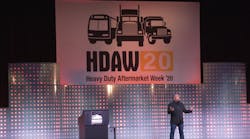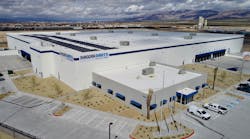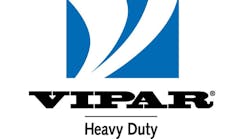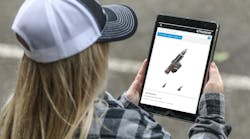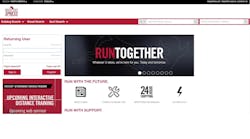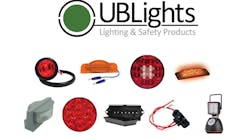WHAT role does price play in the buying decisions of fleets in the commercial-vehicle market?
Bruce Plaxton, president of BGP Marketing Solutions and moderator of a Business & Technical Theater Session earlier this year at Heavy Duty Aftermarket Week, put it like this:
“Everyone is price conscious. Everyone buys some products in some situations on price. Some people buy most or all products on price regardless of the situation. For most people, purchase rationale varies by product and situation.”
He said that while there may be 1001 reasons why fleet managers buy replacement parts, the four primary ones are the product, vehicle age, fleet size, and operational situation.
He said the replacement-parts market is divided into two segments:
- Predictive.
Examples are filters, coolant, motor oil, and brake shoes. “The more predictive the part is — “You have to do this every 5000 miles” — the more price sensitive it is.
- Non-predictive.
Examples are clutches, seats, evaporators, hoods, and fenders. “Even the largest fleet cannot predict, ‘I'm going to need a replacement hood or fender.’ They don't know when that accident is going to occur.”
Plaxton said that based upon research conducted by BGP Marketing Solutions in the past six months, most fleets that purchase new temp-controlled trailers will trade, sell, or otherwise dispose of the trailers in seven to nine years. He said that is important to distributors because the same manager for the same part will make a different decision on a part for a 4-year-old trailer than he would for an 8-year-old trailer.
“The larger the fleet, the higher percentage of non-warranty predictive parts usage, and hence the sharper the pencil,” he said. “Most owner/operators will replace a headlight himself and often pre-buys a headlight at Wal-Mart or Farm Fleet to protect himself from being ‘ripped-off’ at a truck stop.
“Generally speaking, the larger the fleet, the greater the likelihood that management understands to the penny the cost of downtime. It's a case of, ‘If it is broke, fix it now,’ because this shipment has to get from point A to point B.
“Let's say we have this operational situation: It's August in the Mohave Desert. You're carrying frozen pizzas, and the condenser fails. Is price the issue? No. ‘I really need to get it fixed and fixed now, because somebody is waiting to have a piece of pizza.’
“In non-predictive situations, availability is the key. Is the part on the shelf? If it is not, the firm with the part on the shelf will capture the business most of the time, if the fleet manager knows who to call. If you've never called on a fleet, and his truck breaks down and he doesn't know who you are, he's probably not going to pick up the phone and call you. He may call your competitor.
“Is the part on the shelf? That's only part of the equation. There's turnaround time. Say a load has to go from point A to point B and a dealer couldn't get those tractors in and out the door in the time frame required. Those situations occur hundreds, if not thousands, of times every day.”
An inside look
Claxton was joined on the panel by four fleet managers who provided a glimpse into their companies and buying habits:
-
Steve Duley, VP of purchasing for Schneider National.
He said Schneider National purchases 45 million parts ever year, 64% into inventory and 36% in conjunction with a repair or at the local locations where it's not in inventory. Sixty percent come from an OE. Thirty percent are OE proprietary and 70% are all makes.
The purchasing organization is based in Green Bay, Wisconsin, where the following are done: inventory orders, billing, purchasing decisions, overall inventory management, and central warehouse and distributing.
Functions done in the field: non-inventory parts purchasing, receiving/issues/stock room, and non-stock purchases.
He said the company prefers to have its own part number, preferably bar-coded, on paperwork. He said it likes to central-order for multiple locations.
Duley said decisions are based on: whether the part meets quality specifications and standards; service performance (fill rate: 92% regional, 98% national); price; nationwide price and service; central order and billing for multiple ship-to locations; breadth of product line (fewer suppliers); and the ease and efficiency of doing business (EDI, fax, shop frequency, EOQ, SNI part number bar code/paperwork).
“In general, we seek the best overall value, not just pricing,” he said.
-
Sid Gooch, managing director of vehicle maintenance for FedEx Express.
He said FedEx Express has 673 shop locations, 1659 technicians, 82 fleet managers, and eight senior fleet managers.
Gooch said FedEx consists of a family of companies that operate independently to ensure the greatest possible operating effectiveness of each. In this way, each operating company can focus on services and value needs of its customers.
“Each company operates independently, although we compete collectively,” he said. “To simultaneously support the unique needs of all our operating companies and ensure the lowest possible total cost to the corporation, purchasing for FedEx is performed at both the corporate and individual operating company levels. That's something that's confusing to lot of people.
“FedEx sources and contracts for products and services that are employed by multiple operating companies. Through the Enterprise Strategic Sourcing organization, we can optimize our supply relationships for FedEx as a whole. At the operating company level, FedEx continues to purchase products and services that are highly unique to that operating company. In this manner, we are able to match our supply programs to each operating company's requirements ensuring its operating effectiveness.”
He said FedEx is committed to reducing total costs through supply-chain management excellence. He defines that as “managing the business process from the initial supplier to the ultimate customer, focusing on speed and flexibility, resulting in the lowest total cost and highest customer satisfaction — from supplier's supplier to customer's customer — with supply decisions based on total life-cycle costs. High standards for service and quality from FedEx suppliers will never be compromised. We at FedEx look for quality products and services delivered on time and at competitive prices resulting in the lowest total cost of ownership. That cost of ownership originates when we order the part and how we order the part. We work to reduce our total parts costs, not just the price we pay for the part. FedEx selects its suppliers based on their ability to meet our stringent requirements and the capability to serve as a supply chain improvement partner.”
Gooch said Fed Ex spends $84,097,291 per year on parts, $5,023,000 on oil and lubricants, $17,500,000 on tires, and $6,246,825 on parts in stock.
-
Carl Lyth of PepsiAmericas/Globe Transport.
He said PepsiAmericas, as the second-largest Pepsi bottler in the world, manufactures, sells, and delivers more than 100 different beverages to 120 million consumers throughout the US, Central Europe, and the Caribbean.
“Because we're an independent company, we control all components of our operation, including pricing, marketing and distribution,” he said.
The fleet team is part of the PepsiAmericas Supply Chain Group, with 14 fleet managers.
“We are supplied national account programs from the PepsiCo Global Fleet Procurement Team and we are given more than one of each type to pick from, and then we also have to make our decisions on that based on our regional needs,” Lyth said.
Most national agreements are generated through PepsiCo Global Fleet Procurement. Regionally, fleet managers decide which vendor programs can be applied in their areas. Vendors must supply quality, cost-effective goods and services.
“Cost is the key to open the door,” he said. “I'm not going to tell you that's not something we don't look at. However, quality and support are the final determining factors.”
Training is a key element of product support.
“We depend on our vendor's replacement suggestions to show us why that part works better for our application, why that part is more reliable at a better cost, and why you as a supplier are the right supplier to take care of that location,” he said. “We demand a clear line of information access from our major suppliers.
“Not all suppliers do a great job of supporting our smaller locations. Everybody wants to deal with Chicago. There's no problem getting parts for St Louis. But we are a global business built from many strong local ties. We do run our fleet business differently in Twinsburg, Ohio, versus New Philadelphia, Ohio.”
The company keeps its equipment a long time, so direct replacement aftermarket parts are a viable option.
“We won't always go to the OEM the second half of that vehicle's life,” he said. “If we have a good-quality alternative, we definitely look at it. When we make a change from the OEM, we expect support, not just the cost-saving effect. We also look for longevity. Many current programs are forged from long-term relationships. The worst thing that could happen to us is a key supplier builds their business on price, and prices themselves out of a market and is gone. Because then who do we go to to replace that segment of the business we always depended on?”
-
Kevin Tomlinson, director of maintenance for South Shore Transportation.
South Shore is a Sandusky, Ohio-based regional carrier of building supplies that also hauls finished product between warehousing and local stores, and hauls bulk product into manufacturing facilities and hauls out finished product.
Four terminals are located in Ohio (Gypsum, Milan, Medina, and Washington Court House), with one in Michigan (Grand Ledge).
The company has 200 power units (a mix of three OEs) and 450 trailers (predominately flatbeds). The average length of haul is 250 miles.
“Being in Ohio, we can use one vendor in most cases because they're centrally located and I can order from them locally and from the same company in the southern area,” Tomlinson said. “If there's a problem we've discovered with that product, then we can switch to a different product. In most cases, we stick with that OE brand. We cannot afford to have truck problems because of a product malfunction. We're trying to sell our trucks to move freight, and if we can't show we can do that, people go somewhere else.
“We do not keep a lot of inventory parts. My OEs are pretty close to me. I can get parts within the day. We're not under any contracts with anybody. Price is definitely always a factor, but I'm going to buy that same part from an OE and that same part from a distributor, and then we'll haggle on the price of the parts. The fact that the OE has the part and I can get it quickly works out well, and the same with a distributor.”
A question of brand
Plaxton posed a question to the fleet managers: “How do you decide whether you're going to buy, instead of a national-branded part that may be manufactured in the US — ie Bendix, Meritor — something that comes in a white box or private-label box?”
Duley: “We start with a product, and once we've qualified the part, we look at who the supplier is. We do an interview, look at their capabilities. If the part meets our specifications and needs, we would then move to the price element. If there is a price element of going with a non-branded part, if the quality and availability is there, we make that move. If this is a high-frequency part, a high-value part very critical to the operation, we put lot of effort into doing this carefully.”
Lyth: “Typically I'm much more comfortable with branded parts, but I can't say we don't use parts that are manufactured overseas. A lot of our equipment is actually manufactured overseas. I nose around the bigger fleets and pay attention to what they're doing. If a supplier comes and says, ‘This is a new, great thing,’ I ask, ‘Who else is doing this?’ I don't like to lead the parade. A lot of times, being the leader, you get hit by the bugs. If you can come to me and show me there are other companies that may have more resources than we have for research and they're using that part or component, that's a reasonable part to look at. Typically we don't do it with brakes or steering, but we'll see how the part tests out over the short term.”
Gooch: “Generally speaking, we don't use will-fit parts, but there are certain ones we look at — such as windshield-wiper blades. In determining if we're going to use that vendor if it's not a name-brand company we've dealt with, we'll take several locations and put a small number of products in service and take it through the lifespan of that product. In the case of wiper blades, which have a short span, we'll determine if it's going to give us the same life and quality as the parts we were originally using. If it passes all tests, we accept it and put it into our parts system.”
Tomlinson: “I don't know that I would ever use anything that's not branded. As for new products, I'm always interested in trying them, but I would have to know the vendor, who's building this. If normally I can rely on this product by brand, then that's what I use.”

